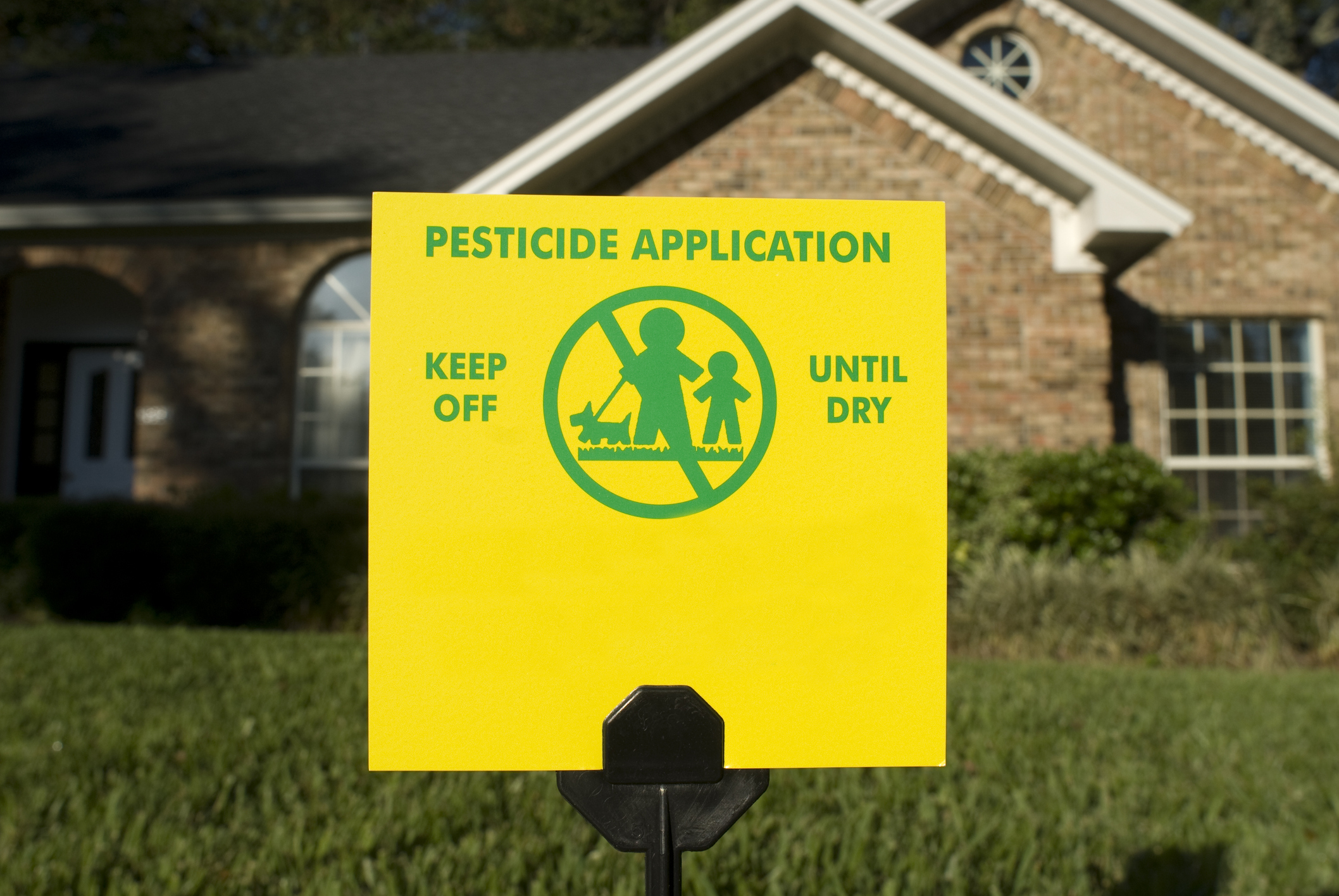
Protect Your Pup from Pest Control Chemicals This Spring
Melting snow, longer days and rising temperatures indicate that spring is finally here. Many pet owners and their furry friends have been longing to take advantage of the nicer weather and head outside for long walks and play sessions in the park. However, spring is also a common time for yard work and landscaping on both public and private property…and that means pesticides, herbicides and other lawn chemicals—many of which are toxic to animals. This can be a dangerous time for dogs!
Whether you’re planning to use lawn chemicals on your own property or are taking a stroll through your neighborhood or local park, it’s important to be mindful of lawn care products and their potential effects on your pup.
The dangers of lawn care products

Dogs use their sense of smell to learn about the world, and if they’re presented with a new scent, they’re more than likely going to “sniff” it out. They may even decide to use their sense of taste and put things in their mouths! Unfortunately, dogs don’t always know the difference between a foreign substance that’s safe and one that could make them sick. This may lead them to eat grass or other flora that have been treated with dangerous chemicals.
There are a wide range of chemicals that might be used on lawns and gardens to keep pests, insects and weeds at bay. These chemicals may contain ingredients that cause health problems in dogs, but no two chemicals are quite the same. Some might induce short-term nausea, while others could be fatal if they are ingested. Even some fertilizers can be dangerous to pets.
A few common types of chemicals to watch out for include organophosphates and carbamates. These types of products inhibit enzyme pathways within the body and can result in a range of toxic poisoning symptoms. Additionally, phenoxy and benzoic acid herbicides may affect the nervous system, causing twitching, fatigue and muscle weakness.
Because lawn chemicals are often sold under branded names, it’s important to do your own research and review the informational pamphlets given to you before applying chemicals to your lawn. Having a general understanding of pesticides, herbicides and fertilizers—and their effects on pets who eat them—might just save your dog’s life!
Potential health risks
Some dogs get sick immediately after being exposed to lawn chemicals. However, some lawn chemicals may cause more long-lasting problems, including organ damage or cancer. It’s important to understand the various symptoms that lawn chemicals can cause to get your dog help as soon as possible.
If your dog steps on grass or shrubbery that has recently been treated with lawn chemicals, there is a possibility that they may experience a skin-level reaction similar to an allergic reaction. Contact with lawn chemicals could potentially cause itchiness, inflammation and burning. Your pup’s paws are at the greatest risk here.
If your dog’s paws or body is coated in chemicals from walking or rolling around on a treated lawn, they may lick the chemicals off later. Ingestion may also occur by eating mulch, fertilizer or treated grass while outside.
If your pup ingests enough material treated with pesticides, herbicides or fertilizer, they may experience a range of poisoning symptoms, including:
- Vomiting
- Diarrhea
- Fever
- Anorexia
- Seizures and muscle tremors
- Drooling
- Rapid heart rate
- Disorientation or trouble moving
- Labored breathing or respiratory problems
Symptoms of poisoning may occur immediately, but they may also show up hours or even days after ingestion. This can make it quite difficult to discern what the true cause is. Regardless of when symptoms appear, you’ll want to take your pet to the vet as soon as possible, because toxic poisoning can result in death.
Finally, it should be noted that the long-term effects of these chemicals on dogs are still unclear. New research is emerging that potentially link chemical exposure (via inhalation, ingestion and physical contact) to an increased risk of cancer.
Springtime prevention and care

In order to ensure your pup does not experience the potentially fatal symptoms of poisoning due to lawn chemicals, you’ll want to be extra mindful this spring while on walks or even having your own lawn treated. Keep these tips in mind.
- Opt for pet-safe treatments: If you’re planning on having your own lawn or garden treated with pesticides, herbicides or other chemicals, tell the landscaping company that you have pets and discuss pet-safe options they can use when treating your yard. This way, you don’t need to worry about letting your dog out to pee or struggle to get them past the lawn safely while going on walks.
- Follow instructions: Some lawn chemicals are considered “safe” for animals after they have been left to dry or watered into the yard. Always follow your lawn treatment service’s or the product’s instructions to ensure you aren’t exposing your dog to chemicals while they are still able to cause health problems.
- Be mindful of other lawns or parks: When you’re walking in your neighborhood, be mindful of properties that have lawn treatment signs or flags posted. Tighten your pup’s leash to navigate past these houses safely, keeping your dog on the sidewalk at all times. If you’re heading to the park, opt for a designated dog park instead of a general park area. The dog park is less likely to be treated with dangerous chemicals.
- Keep them clean: If your pup walks on grass that you believe has been treated with lawn chemicals recently, wipe off their paws as soon as you get home using a damp towel. You should also remove your shoes at the door to avoid tracking chemicals throughout the house. If your pet has rolled in treated grass, give them a bath to wash any chemicals off their fur. It’s better to be safe than sorry!
By staying vigilant about lawn care chemicals this spring, you’ll reduce your pet’s risk for accidental poisoning and save you both a scary trip to the pet ER!


